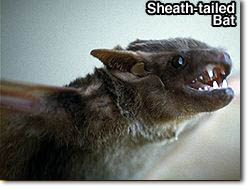Bats
 Several insectivorous species of bats, as well as one fruit-eating bat, occur in the UAE. The most common insect-eating bats are the mouse-tailed bat (Rhinopoma muscatellum ) and the sheath-tailed bat (Taphozous nudiventris ) followed probably by the leaf-nosed bat (Asellia tridens ). These are small bats with bodies only a few cms in length and a wingspan of 20 to 25 cms. All three are active at night, spending their days suspended from the ceiling of a cave, in rock crevices, hollow trees or under the roofs of old buildings. They are gregarious animals that may gather in quite large numbers. Pregnant females separate themselves from the main group towards the end of the gestation period, and in an undisturbed corner they give birth to their young while hanging upside down. The young bats are born blind, without fur and immediately cling to the mother. After a few days their eyes open and soon thereafter they leave the mother's body to hang by themselves, but they are still dependant on the mother's milk. As several females often use the same quiet corner of a colony's cave to give birth, the nurseries can contain considerable numbers of young bats. Several insectivorous species of bats, as well as one fruit-eating bat, occur in the UAE. The most common insect-eating bats are the mouse-tailed bat (Rhinopoma muscatellum ) and the sheath-tailed bat (Taphozous nudiventris ) followed probably by the leaf-nosed bat (Asellia tridens ). These are small bats with bodies only a few cms in length and a wingspan of 20 to 25 cms. All three are active at night, spending their days suspended from the ceiling of a cave, in rock crevices, hollow trees or under the roofs of old buildings. They are gregarious animals that may gather in quite large numbers. Pregnant females separate themselves from the main group towards the end of the gestation period, and in an undisturbed corner they give birth to their young while hanging upside down. The young bats are born blind, without fur and immediately cling to the mother. After a few days their eyes open and soon thereafter they leave the mother's body to hang by themselves, but they are still dependant on the mother's milk. As several females often use the same quiet corner of a colony's cave to give birth, the nurseries can contain considerable numbers of young bats.
The Egyptian fruit bat (Roussetus aegyptiacus ) also lives in colonies, but might not be present in the UAE throughout the year, since the animals tend to migrate, depending on the availability of ripe fruit. With a body length of approximately 15 cms and a wingspan of around 60 cms it can be distinguished from other bats that occur in the region by its size. The fruit-eating bat is also only night active, sleeping in caves or old buildings during the day. It used to be present in considerable numbers at certain times of the year, but excessive use of pesticides seems to have taken a heavy toll amongst this species and today it is only rarely seen.
|